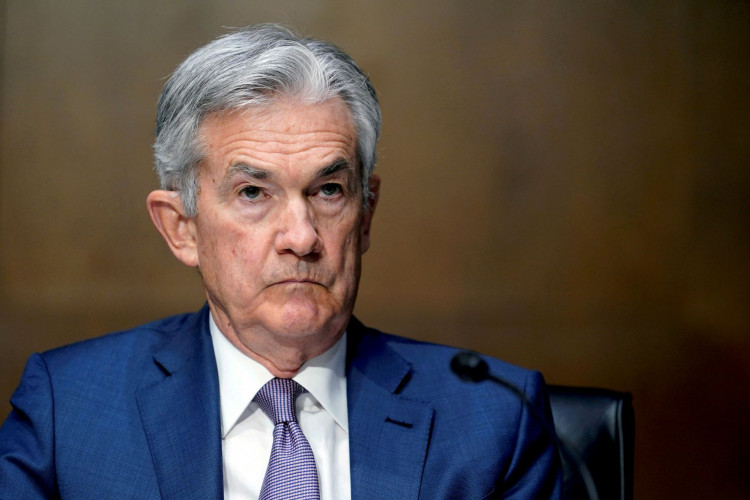In the policy meeting that concluded on Wednesday, the Federal Reserve opted to keep rates unchanged, maintaining the federal funds rate target range at 5.25%-5.5%, in line with expectations. This marks the highest interest rate level in 22 years.
The recently released dot plot suggests that the Fed is likely to hike rates once more this year. The central bank also raised its economic growth forecast for the year.
This marks the second time this year the Fed has paused its rate hikes. Since initiating a tightening cycle in March 2022, the central bank has raised rates 11 times. In its June meeting, the Fed chose to skip a rate hike to assess the impact of its previous policies and monitor inflation trends. However, it resumed its tightening stance with a 25 basis point hike in July.
Fed Chairman Jerome Powell, in the post-meeting press conference, conveyed that officials are "prepared to raise rates further when appropriate and intend to maintain a restrictive policy stance until they are confident that inflation will consistently decline to meet their objectives."
"We are committed to achieving and maintaining a sufficiently tight monetary policy stance to bring inflation back to our 2% target over time," Powell added.
The federal funds rate determines the interest rate for interbank overnight loans and influences various consumer loans, including mortgages, credit cards, and auto and personal loans.
Powell emphasized that the Fed will "act with caution" when evaluating new data and the ever-changing outlook and risks, echoing his remarks from last month.
In a meeting held in Jackson Hole, Wyoming, in August, Powell expressed reluctance to declare prematurely that the Fed had triumphed in its battle against inflation. He noted that the recent slowdown in inflation was just the beginning of building confidence in a sustained downward trend. There were also signs that economic activity was stronger than anticipated, which could pose risks to further progress in reducing inflation.
On Wednesday, Powell pointed out that after the rapid rate hikes last year, "we believe we are now fairly close to where we need to be."
The rate decision was unanimously approved by all voting members. The post-meeting policy statement largely mirrored the rhetoric from the July meeting, reiterating that the "Committee will continue to assess new information and its implications for monetary policy." The primary adjustments were in the economic evaluations.
The Fed described economic activity as "robustly expanding," a shift from the previous "moderate" description. The report also noted that employment growth has "slowed in recent months but remains strong," contrasting with the previous characterization of the employment situation as "strong."
Besides maintaining rates at a relatively high level, the Fed will continue to reduce its bond holdings. Since June 2022, the Fed has reduced its balance sheet by $815 billion.
The released dot plot showed that 12 out of 19 policymakers anticipate another rate hike by year-end, consistent with June's expectations. Seven participants had differing views, one more than in the June meeting. Fed Governor Adriana Kugler did not vote in the last meeting. The Fed will hold policy meetings in October and December.
The median forecast among the 19 officials suggests that by the end of 2024, the federal funds rate will drop to 5.1%, higher than the 4.6% projected in June. This implies that if rates are hiked again this year, there will only be two rate cuts next year, two fewer than previously anticipated.
The Fed also raised its 2025 federal funds rate median forecast from 3.4% to 3.9%. In the longer term, policymakers project a median rate of 2.9% for 2026, higher than the so-called "neutral" rate.
The "neutral" rate is the level that neither stimulates nor restricts economic growth, which Fed officials believe is around 2.5%.
Apart from rate forecasts, Fed officials significantly raised this year's economic growth forecast, predicting a 2.1% increase in the U.S. Gross Domestic Product (GDP), more than double the projection in June. This suggests officials anticipate no imminent recession in the U.S. The GDP growth forecast for 2024 was also revised up from 1.1% to 1.5%.
The expected inflation rate, measured by the core Personal Consumption Expenditures (PCE) price index, was revised down to 3.7%, a 0.2 percentage point drop from June. The unemployment outlook was also lowered from 4.1% to 3.8%.
Current U.S. inflation remains above the Fed's 2% target. Data from the Department of Labor shows that the Consumer Price Index (CPI) for August rose 3.7% year-over-year, higher than the previous 3.2%. The core CPI increased by 4.3% year-over-year.
The PCE price index, favored by the Fed, rebounded to 3.3% year-over-year in July from 3%; the core PCE index, excluding food and energy, slightly rose from 4.1% in June to 4.2% in July.
Meanwhile, amid high interest rates, the labor market is slowing. The U.S. added 187,000 jobs in August, significantly below the monthly average increase of around 400,000 in 2022. The unemployment rate rose by 0.3 percentage points to 3.8%.
Influenced by rate hike expectations, U.S. stock markets declined across the board on Wednesday. The Dow Jones Industrial Average fell 76.85 points, or 0.22%, to 34,440.88. The S&P 500 dropped 0.94% to 4,402.2. The tech-heavy Nasdaq Composite Index declined 1.53% to 13,469.13.






